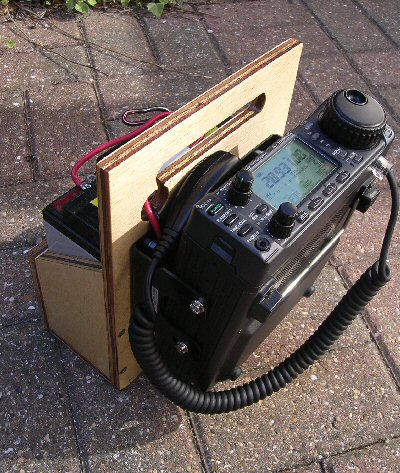Tranceiver cradle for portable radio work


Because it can be a bit of an effort to set everything up each time I wanted to 'go on air' I needed a portable and convenient way of making sure as much of the gear could be brought together ready for immediate use. I needed a sort of 'micro-shack' alternative - that's what is descried here.
I made a number of attempts at this over the years and some designs have even included provision for an ATU, SWR meter and storage for log book, pens and scrap paper. But I found that even these were 'too big' and eventually got 'tidied away' and so eventually necessity lead to the current 'bare minimum' design.
The basic design of the transceiver cradle is shown in the photos. A robust and simple wooden frame houses a lead acid battery and a IC706 mobile transceiver. The unit consists of 5 wooden pieces made from 1/2" (12mm) plywood. The largest of which is the central sheet having a carrying handle slot cut-out near the top. On either side of this is attached a simple rugged draw to take the lead acid battery and the U-bracket mount for the transceiver. Close to the handle I also cut a circular hole about 1" diameter which (depending in the radio orientation) allows for the 706 Microphone to be easily fitted into the transceiver.
The main wooden sections have dimensions 8" x 10 1/2" (20.5 x 26.6cm) with a 5" (13cm) long 1" (2.5cm) wide slot handle cut into it 1" (2.5cm) from the edge. The base section (underneath) is 8" x 3 1/8" (20.5 x 8cm) while the back section of the battery tray 8" x 4 1/2" (20.5 x 11cm). The side panels had a highest side 6" (15cm) sloping down to 4" (10cm) with a width of 3 1/8" (8cm).
I used 16 1 1/2" (4cm) chip board wood screws to hold the 5 wooden pieces securely together, gluing all the sections with wood glue for extra strength (my battery alone weighed about 6kg so you need to be a little careful handling the unit).
The back section was secured by 5 screws, the bottom section by 4 screws (up into the side panels) while 7 screws went through from the main section. You need to consider how you place some of the screws so that the shafts don't meet in the wood. All the screws were countersunk.
Start assembly with the main (largest) section and screw in the base with screws that go through into the side of the base. Then fix the sloping side panels. The back (of the battery) section is the final piece to fix in place. Next, try a few positions for the U-bracket (with the radio in place) taking into consideration the space you will needed for the antenna connections and cables. Then mark the best place for the 4 bolts to fix it in place and drill. Before fitting the bracket and battery I gave the unit two or three coats of marine varnish to look more professional and to help keep out moisture while 'out and about'.
The battery compartment was made to snugly fit a 17AH 12V sealed lead acid battery but a 12V motor bike battery might be a cheaper alternative. The fit should not be too tight as the wood will naturally change shape over time (the battery might need to be removed later). Further, the radio bracket bolt heads come through the central panel into this battery area. Use counter sunk bolts and a little insulation tape padding on the bolt heads to protect the battery case.
In use The IC706 has its two PL259 antenna sockets at the rear. Although I designed enough space to fit most plugs and their cables via these sockets it has to be said that the use of right angle PL259 adapters really helps to simplify antenna connections while out in the field (you can just see one in the picture).
The transceiver can be fitted into the U-bracket so that it faces inward toward the carry handle/battery or facing away (as shown). I found that the later provided a comfortable angle for portable work. The weight of the battery being enough to firmly hold everything in place while on the ground or table top. The handle means the unit can be moved around really easily and seems to be well balanced. After years of wiring up radios on-ones-lap, in all sorts of places, this arrangement is very nice to use!

back to radio page
THE CREATIVE SCIENCE CENTRE
home | diary | whats on | CSC summary | latest news